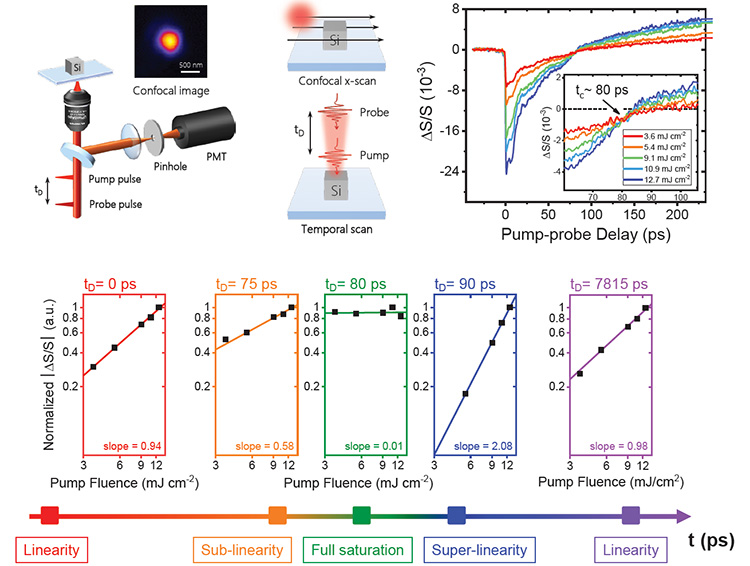 Top left and center: Schematic of a confocal pump–probe spectro-microscope system. Top right: Pump–probe traces of the Si nanoblock sample measured at various pump-fluences. Bottom: Temporal evolution of transient nonlinearity.
Top left and center: Schematic of a confocal pump–probe spectro-microscope system. Top right: Pump–probe traces of the Si nanoblock sample measured at various pump-fluences. Bottom: Temporal evolution of transient nonlinearity.
Silicon nanostructures support a wide range of electric and magnetic Mie resonances that can significantly enhance both linear and nonlinear light–matter interactions. Nonlinear photonics is fundamental for many applications such as optical signal processing, which requires high-speed and large modulation. Two years ago, we reported a giant photothermal optical nonlinearity in silicon nano-resonators, where the nonlinear index n2 presented an enhancement of five orders of magnitude relative bulk silicon, with the potential to support a GHz all-optical switch.1
In work reported this year, we have further expanded the playground by combining spatial x-scan and temporal pump–probe techniques onto silicon nanocuboids, thereby unraveling transient nonlinear behaviors that change signs over periods of a few picoseconds. The fluence-dependent pump–probe trace (upper-right panel in accompanying figure) shows an interesting “crossing point” at an 80-ps time delay, where the probe remains constant as pump fluence increases, featuring a surprisingly full saturation power dependency (slope = 0; green panel in figure). Immediately before the full saturation point, at a 75-ps time delay, the power dependency becomes sublinear (slope ~ 0.6; orange panel). On the other hand, after the full saturation point, at a 90-ps delay, it becomes super-linear (slope ~ 2; blue panel).
The underlying mechanism is fluence- dependent carrier lifetime via nonlinear Auger carrier recombination—shown by the fact that, at time zero and 8-ns delay, when the Auger process does not dominate, the power dependency returns to unity. Since the Auger effect exists not only in indirect-band-gap materials like silicon but also in direct-band-gap materials, we envision that the transient nonlinearity with ultrafast sign flip we have demonstrated should be generally applicable to all-optical control over scattering and emission. Furthermore, our group is devoted to developing novel microscopic methods, and we have demonstrated sub-diffraction imaging via point-spread-function engineering with the transient nonlinear response.
Researchers
Guan-Jie Huang, Yu-Lung Tang and Shi-Wei Chu, National Taiwan University, Taiwan
Hao-Yu Cheng and Kung-Hsuan Lin, Academia Sinica, Taiwan
Hotta Ikuto and Junichi Takahara, Osaka University, Japan
References
1. Y.-S. Duh et al. Nat. Commun. 11, 4101 (2020).
2. G.-J. Huang et al. Adv. Opt. Mater. 10, 2101711 (2022).

